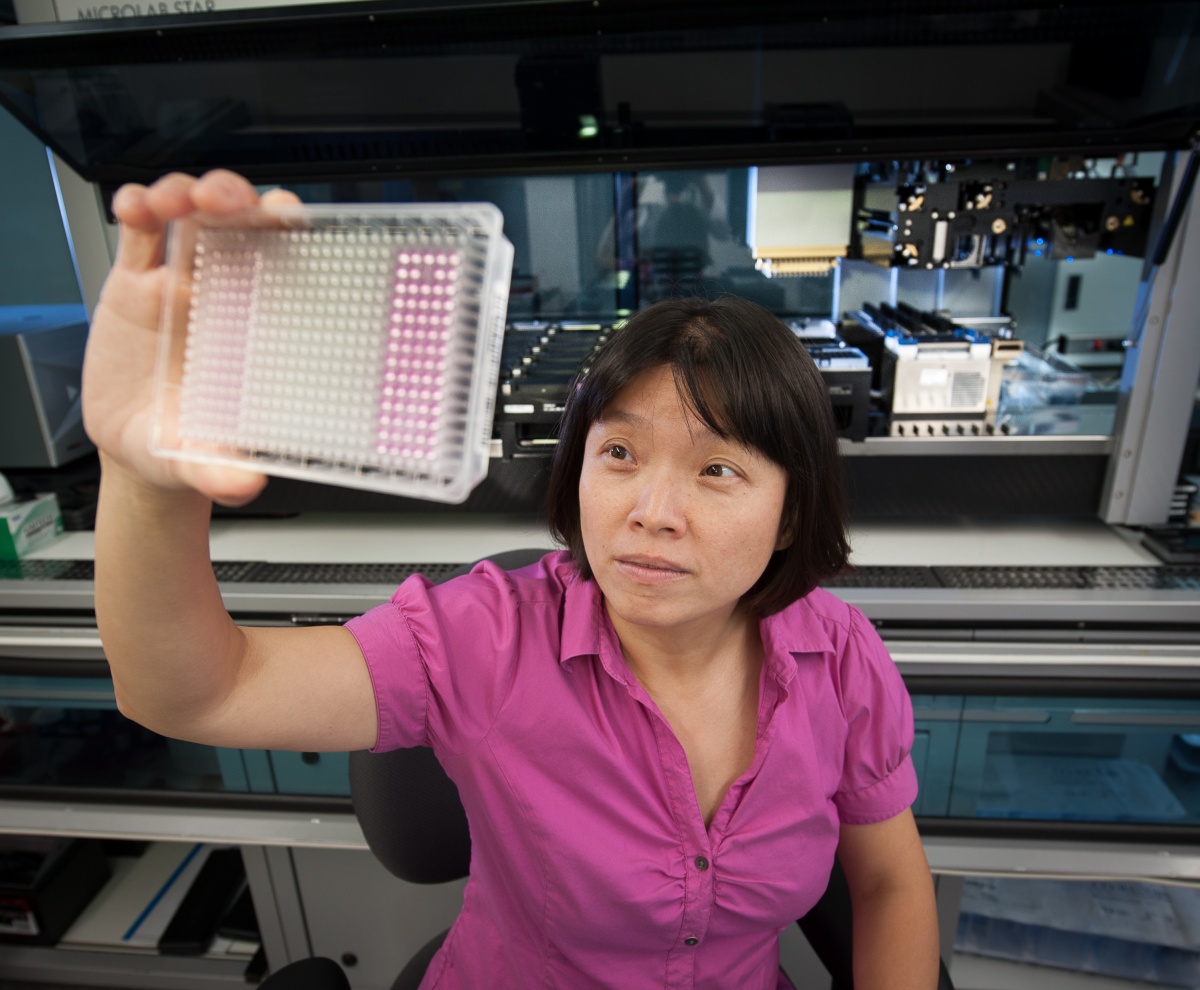News
Low-Cost Sequencing Technique Helps Advance Personalized Cancer Treatment

Research scientist Hai Li holds up a 384-well plate, pictured in front of Columbia Genome Center's Hamilton Star automation system for HTS; Image credit: Systems Biology
Drug screening and analysis is critical in advancing research and discovery of cancer therapeutics. To this end, a Systems Biology-led team of investigators has recently developed PLATE-Seq, a new technique for low-cost, bulk mRNA sequencing. Coupled with genome-wide regulatory network analysis, the novel PLATE-Seq method advances the goal of providing cancer patients with personalized treatment.
Developed by the labs of Peter Sims and Andrea Califano , PLATE-Seq stands for “pooled library amplification for transcriptome expression” sequencing, and enables genome-wide mRNA profiling specifically designed to complement high-throughput screening assays. High-throughput screening, or HTS, represents a key component of drug discovery and technology used widely in biomedical research. Due to cost or complexity, most screens are still performed using low-complexity reporters, such as cell viability, protein-protein interactions and cell growth, for example, but there is a growing need to couple this screening protocol with genome-wide reporters, to measure the activity of many proteins across the genome.
“Our PLATE-Seq method helps us generate a more comprehensive portrait of drug activity,” said Dr. Sims, assistant professor of systems biology, known for his innovative work in single-cell RNA sequencing. “We’ve been able to show that our technique cuts the cost for gene expression profiling considerably, by incorporating a method we devised for ‘barcoding’ cDNA samples and combining this with computational methods from the Califano Lab that are highly effective on low-coverage sequencing data. This method allows us to sequence 96 samples per plate and 768 samples per sequencing run.”
On average, PLATE-Seq reduces the cost of genome-wide screening from around $400 per sample down to approximately $25 per sample. Genome-wide sequencing is important in advancing our understanding and prediction of disease and in identifying potential treatments.
Dr. Sims collaborated on PLATE-Seq with Dr. Califano, the Clyde and Helen Wu Professor of Chemical Systems Biology and chair of the Department of Systems Biology, and Chuck Karan , scientific director at the Columbia Genome Center. Califano’s VIPER algorithm, already in use by the scientific community, makes it possible to find actionable proteins in cancer patients, independent of their genetic mutations. VIPER also tracks tumors as they progress or relapse to determine the most appropriate therapeutic approach at different stages of the disease. In this new work, VIPER is being used on PLATE-Seq data results in order to determine the correct drugs to treat a specific tumor. Dr. Karan, who runs the high-throughput screening facility at Columbia Genome Center , is responsible for automating the PLATE-Seq platform.
“PLATE-Seq allows us to build large-scale databases of drug perturbations in cells representative of many different tumors,” said Dr. Califano. “Specifically, we can assess the activity of all FDA approved and investigational compounds in Phase 2 and 3 clinical studies for about $100,000 per tumor type using either cell lines of primary cells from a patient biopsy. We have already assembled perturbation databases for nine tumor types, which are used in our N-of-1 study. This would have cost us $20M if we had used traditional RNA-Seq methodologies.”
Their work on PLATE-Seq, coauthored by Erin C. Bush, Forest Ray, Mariano J. Alvarez, Ronald Realubit and Hai Li, appeared in Nature Communications .
Central to the PLATE-Seq protocol is a barcoding platform developed by the Sims Lab and its pooled library construction protocol. Built on previous work, Sims’ method for barcoding samples makes it possible to efficiently prepare samples for RNA sequencing in a high-throughput manner by taking a 96-well plate and collapsing it into one library. “Rather than preparing individual sequencing libraries for each of 96 samples, we can pool all of our barcoded cDNA libraries into a single tube, dramatically reducing reagent and labor costs,” explained Dr. Sims.
To test the PLATE-Seq technique, Dr. Sims and team conducted a fully automated 96-well screen to profile BT20 breast cancer cells treated with seven different drug compounds, and compared the results to a well-established, more expensive sequencing method. The two methods identified very similar patterns of differential gene expression.
“The goal is to build large databases of drug perturbations. Soon we will have drug perturbation coverage for more than 80 percent of human tumors,” said Dr. Califano. “There are definite hurdles in front of us but that’s where we are headed.”
Next for PLATE-Seq, Sims, Califano and collaborators intend to fine tune their method and continue to branch out from sampling secondary cell lines to patient cells extracted from a cancer tumor. They will also look beyond cancer into other diseases, including Alzheimer’s.
“PLATE-Seq will be a defining technology for the HTS facility,” added Dr. Karan. “We’re at the stage now where we have the machine rolling and we want to see where it can be applied going forward.”
-Melanie A. Farmer